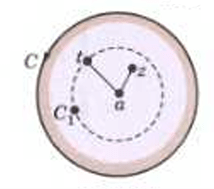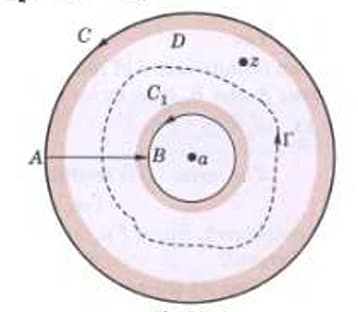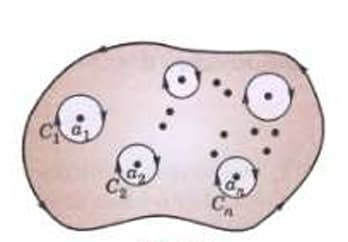Let me be very clear: math is all about practice, and there are no shortcuts. So, please refer to B. S. Grewal's book for theory and practice questions. Here, I can only provide video links to help you understand the topic.🙂
Cauchy's Theorem
Cauchy's Theorem is one of the central results in complex analysis. It provides a foundation for several powerful results in the study of analytic functions, such as Cauchy's Integral Formula, the Residue Theorem, and the Laurent series.
Let be a function that is analytic (holomorphic) inside and on a simple, closed contour C in a domain D. Then the contour integral of f(z) around C is zero:
-
Analytic (Holomorphic): A function is said to be analytic at a point if it has a derivative at and in some neighborhood around . In other words, is infinitely differentiable in this region.
-
Simply Connected Domain: A domain D is said to be simply connected if any closed contour within D can be continuously deformed to a point without leaving D. This implies that the domain contains no "holes".
-
Contour: A contour C is a piecewise smooth, closed curve in the complex plane. Cauchy's Theorem requires that C be simple, meaning it does not intersect itself.
Cauchy's Integral Formula
It is not a single video but a playlist, and it contains three videos. When one video finishes, the next will play automatically.
Cauchy's Integral Formula
Let f(z) be a function that is analytic inside and on a simple closed contour C in a domain D, and let be any point inside C. Then for any inside C, the value of the function is given by the contour integral:
This is Cauchy's Integral Formula.
Key terms
- Analytic (Holomorphic): A function f(z) is analytic at a point if it has a derivative at that point and at all points in some neighborhood of that point.
- Contour C: A simple, closed, and piecewise smooth curve in the complex plane.
- : Any point inside the contour C.
The formula can be generalized to give the value of any derivative of inside the contour C.
Generalized Formula for Derivatives: Let f(z) be analytic inside and on C, and let be a point inside C. The n-th derivative of f(z) at is given by:
This result allows us to calculate higher-order derivatives of an analytic function at points inside C based solely on the values of the function on the contour.
Taylor's and Laurent's Series
It is not a single video but a playlist, and it contains three videos. When one video finishes, the next will play automatically.
Taylor's Series:
If f(z) is analytic inside a circle C with centre at a, then for z inside C,
Proof:
Let z be any point inside C. Draw a circle with centre at a enclosing z (Fig.).

Let t be a point on . We have
As , i.e., , this series converges uniformly. So, multiplying both sides of (ii) by f(t), we can integrate over .
Thus,
Since is analytic on and inside , therefore, applying the formulae, we get (i) which is known as Taylor's series.
Laurent's Series:
If is analytic in the ring-shaped region bounded by two concentric circles and of radii and () and with centre at , then for all in
where
being any curve in , encircling (as in Fig.).

Proof: Introduce cross-out , then is analytic in the region bounded by , , described clockwise, and described anti-clockwise (Fig. ). Then if be any point in , we have
where both and are described anti-clockwise in (i) and integrals along and cancel (Fig.).
For the first integral in (i), expanding , we get
where
For the second integral in (i), let lie on . Then we write
As , i.e., , this series converges uniformly. So multiplying both sides by and integrating over , we get
where
Substituting from (ii) and (iii) in (i), we get
Now being analytic in the region between and , we can take the integral giving over . Similarly we can take the integral giving over . Hence (iv) can be written as
which is known as Laurent's series.
Zeros and Singularities
Zeros
A zero of an analytic function is that value of for which . If is analytic in the neighbourhood of a point , then by Taylor's theorem
If but , then is said to have a zero of order at . When , the zero is said to be simple. In the neighbourhood of zero of order ,
Then is analytic and non-zero in the neighbourhood of .
Singularities
It is not a single video but a playlist, and it contains five videos. When one video finishes, the next will play automatically.
Singularities of an analytic function:
We have already defined a singular point of a function as the point at which the function ceases to be analytic.
(i) Isolated singularity: If is a singularity of such that is analytic at each point in its neighbourhood (i.e., there exists a circle with centre at which has no other singularity), then is called an isolated singularity.
In such a case, can be expanded in a Laurent’s series around , giving
For example, is not analytic where , i.e., at the points or .
Thus are all isolated singularities as there is no other singularity in their neighbourhood.
But when is large, is such a singularity that there are an infinite number of other singularities in its neighbourhood. Thus is the non-isolated singularity of .
(ii) Removable singularity: If all the negative powers of in (1) are zero, then
Here the singularity can be removed by defining at in such a way that it becomes analytic at . Such a singularity is called a removable singularity.
Thus if exists finitely, then is a removable singularity.
(iii) Poles: If all the negative powers of in (i) after the th are missing, then the singularity at is called a pole of order .
A pole of first order is called a simple pole.
(iv) Essential singularity: If the number of negative powers of in (1) is infinite, then is called an essential singularity. In this case, does not exist.
Cauchy's Residue Theorem
It is not a single video but a playlist, and it contains seven videos. When one video finishes, the next will play automatically.
Residues
The coefficient of in the expansion of around an isolated singularity is called the residue of at that point. Thus in the Laurent’s series expansion of around , i.e.,
the residue of at is .
i.e.,
Cauchy's Residue Theorem
If is analytic in a closed curve except at a finite number of singular points within , then
(sum of the residues at the singular points within C).

Let us surround each of the singular points by a small circle such that it encloses no other singular point (Fig.). Then these circles together with form a multiply connected region in which is analytic.
Applying Cauchy’s theorem, we have
which is the desired result.